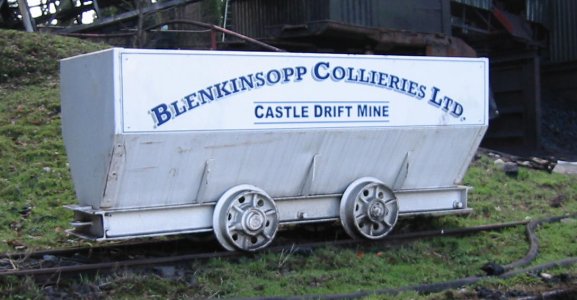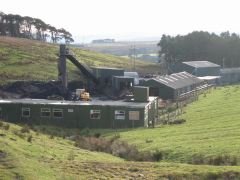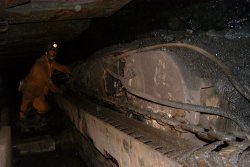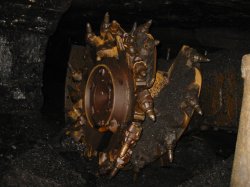Blenkinsopp Colliery
 |
Background
Blenkinsopp Colliery
Unusual in that the pit has never been nationalised, "The Colliery" actually is composed of two interconnected drifts Wrytree and Castle, in West Northumberland.
It seems something of a scam was worked in order to get round the terms of the Private Licence mines arrangements which permitted only 50 men to employed at a private mine. Each drift was constituted as a separate mine and the overall operation was able therefore to employ 100 men.
The workings have a long history, although discovering it is proving difficult. The NUM appears to have organised these mines traditionally and representatives sat on the Regional Executive Committee. The press however at the time of RJB NCB buyout was talking of a local TGWU representative at the pit. Dave Temple of TUPS tells us that a forthcoming book by an old Northumbrian miner will detail his work at the colliery and perhaps tell us more of its history.
Formerly large parts of the workings were in the take of Byron Colliery, and Roachburn Colliery, both of which closed in 1908, the former following a disaster in that year, although as yet we have been unable to find any details.
The pit relies on traditional conventional mining skills, working pockets of coal from the former takes, in the Little Limestone seam using Board and Pillar work, hand filling and limited mechanised mining where applicable. The current operation comes from a longwall face. About 130 men work at the pit but the Coal Report estimates this will fall to 97 .All production goes to RJB mining who had previously owned the pit and seems to have been their first mining acquisition.
Current reserves will exhaust in two years, but development plans to the south are expected to open up in excess of 10 million tonnes and give the pit another twenty years life.
This area obviously has a rich mining history and we are trying to unfold more of it, any information on the pit and its coal work would be welcome.
This information on Blenkinsopp was sent to Miners Advice by Clive
Seal, Manager Ayle Colliery. (Hopefully Clive will furnish us with the
details of Ayle Colliery so that we can add the information to these pages.)
Many thanks to Clive for allowing us to use this item.
Blenkinsopp has opened and closed at least 3 times. From 1860-1908 Byron Colliery was called Blenkinsopp as it worked that royalty.
Byron re opened after the disaster in 1908 employing about 80 men working coal above water level from the old fan shaft. The drift was reopened 1920 then also the Castle drift until early 1930's.
The colliery was never nationalised as it was closed at the time. Re
opened by the Wardle family who had owned other pits in the area. First
reopened Gapshields, then Wry Tree and finally Castle.
A licenced mine could employ 30 men if it had a proper certificated manager.
I am told that at one time it was classed as 3 separate mines (which it
was) Wrytree, Fell End (a very old colliery who's shaft was used to ventilate
Wrytree) And Castle.
It was the first colliery owned by RJB when he purchased it off the Wardel's and was the first licenced mine to operate power loading. Budge sold it back (nominal sum) to the Wardles and the colliery manager around 1996. It was also about the best paid pit in the country.
During it's long life (pre 1750) it has had an array of prominent mining engineers inspecting it for the owners, John Buddle, George Stephenson (who described it as one of the best coal works he had ever seen); and Nicolas Wood.
Clive Seal
|
UPDATE James Findlay is currently employed at the Blenkinsopp/Wrytree Mine. Sadly, the mine has been earmarked for closure this year, (2002).
James has been busy recording as much information about the mine as possible, including taking hundreds of photographs which will serve as a pictorial record of the last moments of this, one of Britain's most historical mines. Here are James's own words: I work at the last remaining drift mine in Northumberland (and shortly to close). Blenkinsopp and Wrytree coal mine which are both connected underground
are located in the village of Greenhead, two miles from the town
of Haltwhistle, halfway between Newcastle and Carlisle on the A69.
The mine dates from the middle 1800s (on the drift entrance it shows 1842) although it is possible that it predates this maybe even as early as the 15th century!
There are two unique features of the mine, at the
Blenkinsopp side the drift entrance is less than 20 metres away
from a castle (haunted!) which then runs under a caravan site.
Ellington the other mine in Northumberland also went through the same dyke and came across the same problem of poor quality coal although it improved the further away they went. Alas the pit was running out of time and money to be able to get to the reserves. To see more of James' photographs of Blenkinsopp, take a look at our Image Library - The Pits
|
Hill Top - Kellingley - Longannet - Monument - Maltby -Phoenix and Hopewell - Prince of Wales - Rossington
The Free Miners - The Selby Complex - Thoresby -Thorne - Tower - Welbeck - The Nottingham Coalfield
Mining 2000 Conclusions



